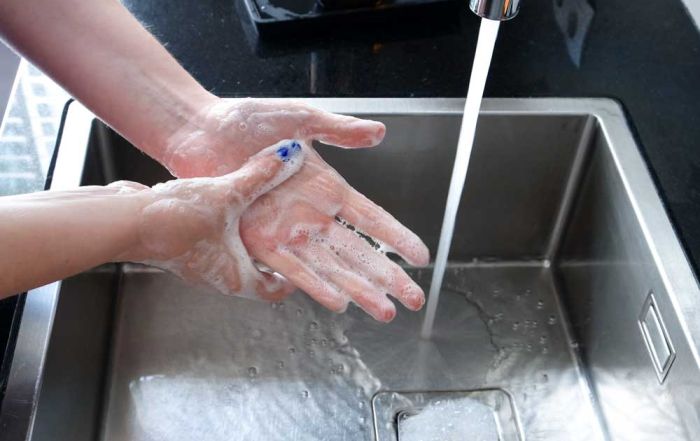Ice Machines, Beverage Dispensers & Other Overlooked Food Safety Hazards
At the end of the spring semester in our campus food production lab, we’re fortunate to have the opportunity to hit pause and reset for the summer and prepare for fall—a luxury many foodservice operations don’t often get. During this time, we can deep clean, shut down equipment, and perform a thorough reset of the space. While some school foodservice programs may also have this seasonal window, many commercial kitchens operate year-round and rarely have the chance to step back in this way.
Among the many pieces of equipment that we focus on cleaning during this time are the ice machine and soda dispensers. We clean them throughout the year, too, but they are pieces of equipment that are sometimes neglected. I can see why some may forget about them. In food safety training, much attention is paid to keeping food at safe temperatures, avoiding cross-contamination, and ensuring hand hygiene. While the spotlight is often on cooking and holding procedures, some food safety hazards are hiding in plain sight: ice machines, beverage dispensers, and other equipment that’s easy to forget during daily cleaning routines.
Ice is considered a food under FDA guidelines, which means it must be handled and stored with the same care as any other consumable. Yet, ice machines are notorious for harboring mold, slime, and bacteria, often due to irregular cleaning and maintenance. Ice scoops left on top of the machine, hands reaching into bins, or contaminated utensils can all introduce pathogens. When was the last time you inspected the water line to your ice machine – or even more importantly, the filter? Just as with any surface, if they are not cleaned and sanitized regularly, the risk of contamination only grows.
In foodservice operations, ice is an important component of the service and production processes. It is used for both beverages and for cooling of food. Thus, it is important to be diligent in cleaning and monitoring ice machines.
…Food safety isn’t just keeping hot foods hot and cold foods cold; it’s about the unseen risks that accumulate over time.
Soda fountains and beverage dispensers can also be a hidden hazard. Sugary syrups and low-acid liquids provide a perfect breeding ground for bacteria and yeast, especially in and around the nozzles and drip trays. These areas often go unnoticed in daily cleaning routines and can develop biofilms—thin layers of microbial growth that are hard to remove and can contaminate drinks. In most cases, the trays themselves are dark in color, often black, meaning spotting these biofilms is not easy to do visually.
Another issue arises with the internal tubing of beverage systems. Without proper flushing and sanitization, residue can build up, leading to off-flavors and microbial risks. In both commercial and institutional settings, ensuring that staff are trained to clean these systems according to the manufacturer’s specifications is essential.
Beyond ice and beverages, there are many overlooked surfaces that require consistent attention. Refrigerator gaskets can collect food particles and condensation, creating a moist, dark environment where mold and bacteria thrive. Handles of reach-in coolers, microwave buttons, and faucet levers are frequently touched but seldom cleaned with the same rigor as food prep surfaces.
Food safety isn’t just keeping hot foods hot and cold foods cold; it’s about the unseen risks that accumulate over time. By creating comprehensive cleaning schedules that include non-obvious equipment and surfaces, and by regularly training staff on the “why” behind those practices, foodservice operations can protect both their customers and their reputations. After all, preventing illness doesn’t just happen on the line—it happens behind the ice machine, under the soda fountain, and everywhere in between. Risk Nothing.
READ MORE POSTS
30 Years Later: The Foodborne Illness Outbreak that Changed Food Safety
In January, we hit a major anniversary. One I am betting snuck by many of you – including me! January marked 30 years since the deadly 1993 E. coli O157:H7 outbreak at Jack in the Box restaurants on the west coast. The anniversary wasn’t on any of the major news networks that I recall. It did make it into a few newspapers, at least one or two of the newspapers that are left. It wasn’t until late-February that I realized it.
Does Temperature Really Matter when Washing your Hands?
In January, I reviewed the changes to the 2022 Food Code in my blog (check out Part I and Part II), and one change to the food code that I had mentioned, but didn’t discuss in-depth, was the change that lowered the water temperature a hand sink was required to produce to 85°F, as noted in Section 2-202.12 of the code. This requirement has been in place since the publishing of the 2001 Food Code, which required a water temperature of 100°F. Prior to this, 110°F was required (see the 1999 Food Code). So why the change and does water temperature when washing your hands really matter?
Hand sinks: Often Taken for Granted, but an Essential Part to Effective Hand Hygiene
Late in January, I received a question about hand sinks in a foodservice operation. The question pertained to school staff (teachers and aides) who were using a hand washing sink in the school kitchen. The question came as a matter of who was allowed access to the kitchen to use the sink, but the question itself caused me to go down a rabbit hole of requirements for hand washing sinks in foodservice operations.
Hot off the Press: The 2022 Model Food Code has been Released! Part Two.
Earlier in the month, we started a discussion about the changes to the 2022 Food Code. If you missed that post, late in December 2022, the Food and Drug Administration released the 2022 Food Code and I wanted to highlight a few of the changes that have been made to the code.










